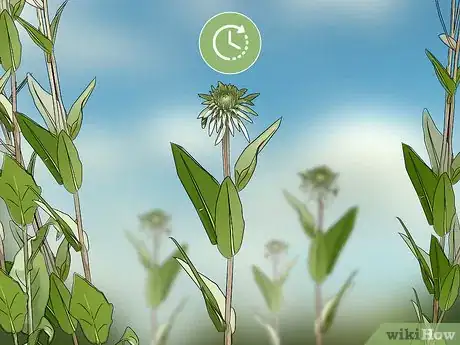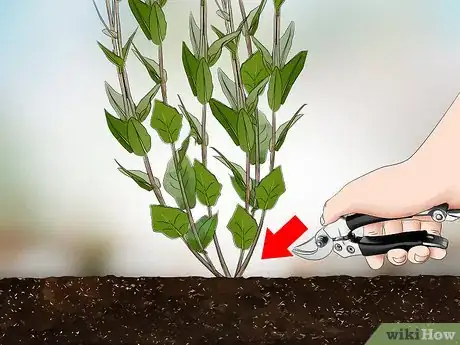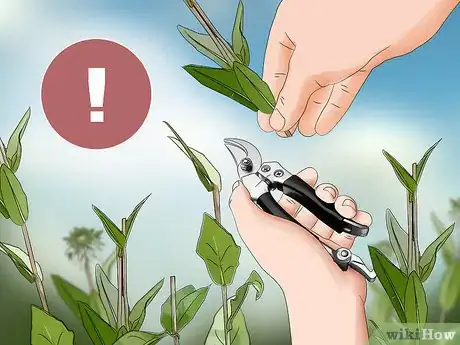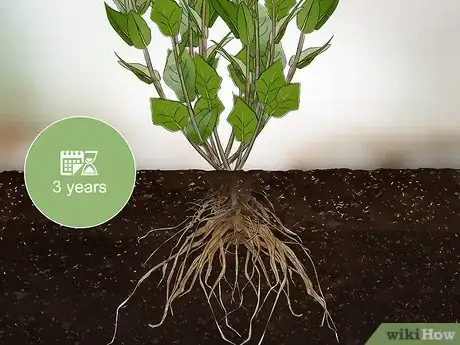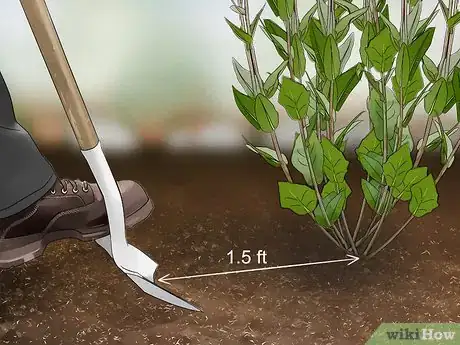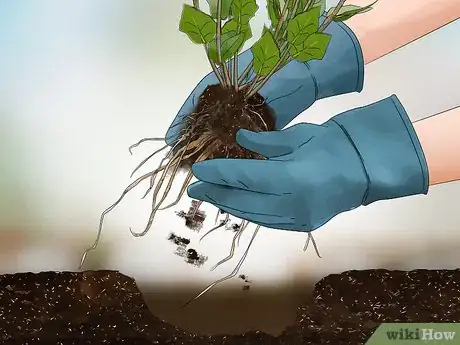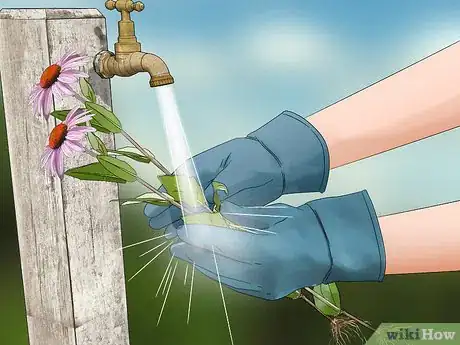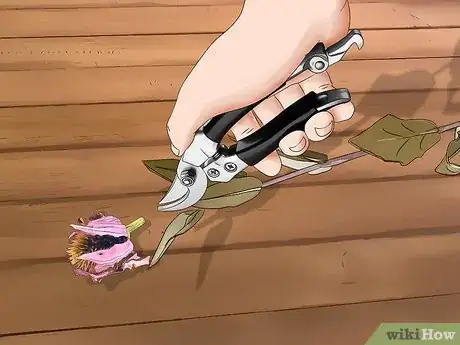This article was co-authored by Lauren Kurtz. Lauren Kurtz is a Naturalist and Horticultural Specialist. Lauren has worked for Aurora, Colorado managing the Water-Wise Garden at Aurora Municipal Center for the Water Conservation Department. She earned a BA in Environmental and Sustainability Studies from Western Michigan University in 2014.
This article has been viewed 37,352 times.
Echinacea, also known as coneflower, is a flower native to North America. The flowers are beautiful, and they are often used as herbal medicine for the common cold and other minor infections. You can use every part of the plant the same way.[1] You can harvest echinacea flowers, stems, and leaves only or harvest the entire plant with the roots attached. Then, dry and store your echinacea so that it will be ready to use whenever you need it!
Steps
Harvesting Echinacea Flowers, Leaves, and Stems
-
1Wait for the flowers to bloom. After planting echinacea, it can take a couple of years for the flowers to bloom. It is important that you do not harvest anything from your plant until after the flowers have bloomed at least 1 time, and then wait for them to bloom again to harvest them. This will help to ensure that the plant is tough enough to withstand harvesting and has an established root system.
- Harvest the flower while it's in bloom and before it starts to fade.
- Keep in mind that echinacea is a valuable garden addition even before you harvest it. It attracts butterflies, provides seed for birds, and repels deer from your garden.[2]
-
2Cut just above a node to harvest a small amount of echinacea. You can cut as much of the echinacea stem as you like, just make sure to cut it right above a node. The nodes are small protrusions on the echinacea where leaves grow. Use a sharp pair of garden shears or scissors to cut the stem of your echinacea right above a node. This method of harvesting is ideal when you want to collect a single stem or just a few stems.[3]
- Repeat this for each of the stems you want to harvest.
Advertisement -
3Cut just above the crown to harvest the whole plant. The crown is located at the base of the plant, just above the roots. Cut up to one-third of the stems right above the crown using a pair of sharp scissors or garden shears to harvest the echinacea plant.[4]
- Do this for each whole plant you want to harvest.
- The plant will grow back the following year.
-
4Avoid over-pruning the plants. Echinacea does not like to be disturbed, so it is important to prune sparingly.[5] Only cut a few stems from each of the clumps and try to clip the oldest or largest ones. Leave the younger stems alone to continue growing.[6]
- Check back once per week while the plant is in bloom to see if there are any older stems that could be harvested before they start to fade.
Harvesting Echinacea Roots
-
1Wait until the plant is at least 3 years old to harvest the roots. Echinacea roots are useful for tinctures and teas, but harvesting the roots means digging out an entire plant. It is best to wait until a plant is mature so that the roots will be as big as possible. This will also provide enough time for some other crowns of echinacea to develop from the original plant.[7]
- It is also best to dig up echinacea by the roots and divide the clumps once every 3 or 4 years. Time your root harvests in the spring or fall when the weather is cool.
- You may only get a few clumps from smaller plants or you may get several clumps from larger ones.
-
2Use a garden spade to dig up the roots. Insert a garden spade into the ground about 1.5 to 2 feet (0.46 to 0.61 m) from the base of the echinacea. Then, use your foot to press down on the spade and lift the plant out by the roots. This will help to ensure that you do not dig into the roots.[8]
- You may also dig a trench around the plant to loosen it up. Just be careful not to dig too close to it so that you do not damage the roots.
- Echinacea has wide and deep roots.
-
3Use your fingers to pull apart the clumps of roots into individual crowns. A crown is the area just above an individual root where the stems of that plant fuse together. Be careful not to break off stems or pieces of the roots as you pull them apart. Separate the larger, older clumps from the smaller, younger clumps and divide them into piles.[9]
- If a clump is too tough to break apart with your fingers, use a pair of garden shears to cut them apart.
- You may also want to shake away the excess dirt to make it easier to see the individual crowns.
-
4Replant any young crowns attached to the older ones. After you have finished dividing the clumps, plant the young ones back in the ground. Place each clump into its own hole about 12 to 15 inches (30 to 38 cm) deep and 1 to 3 feet (0.30 to 0.91 m) apart from each other. They will continue growing and you can harvest the roots from these plants in another 1 to 2 years.[10]
- Make sure that you plant the echinacea in an area of the ground or in a pot with soil that drains well. Avoid tightly packed or clay-type soils.
- Choose an area with full sun or place potted echinacea in a sunny window.
- Water the plant deeply after replanting it.
Drying and Storing Echinacea
-
1Rinse the flowers, stems, leaves, and roots. Before you use any of the echinacea, make sure to give them a thorough rinse. Rinse the roots especially well since they have been in the ground and will be caked with dirt. Use lukewarm or cool water to rinse the plants.
- If your plant's roots have lots of dirt on them still, you may want to take them outside and shake them off first. Don't rinse lots of dirt down your drains because it will likely clog them.
-
2Hang the echinacea plants upside down or lay them flat to dry. You can wrap a rubber band or some string around a bundle of echinacea stems and hang them upside down from a hook on your wall or ceiling to dry them. Place a paper bag over the flowers to catch the dried petals as they fall. Depending on the size of the plant and the warmth of the environment, it may only take a couple of days for the plants to dry, or it may take about a week.
- Another option is to spread out the flowers on a well aerated flat surface, such as a screen that you have taken off the window, and place them outside to dry on a warm, sunny day ou. This should produce dry plants in only 1 to 2 days.
- Some people have also had success with drying their echinacea on a baking sheet left inside of their car. This may produce dry plants in as little as 1 day.
-
3Use a knife or scissors to cut the dried flowers into separate pieces. Cut the flower buds off from the stems, cut the stems into 0.5 in (1.3 cm) pieces, and chop the roots into 1⁄4 in (0.64 cm) chunks. You can divide the plant parts for different uses or mix them together.
-
4Store the dried echinacea in jars. Use jars that have screw tops or locking lids to keep air and moisture out. You can store the different flower parts together in a single jar since all of the parts can be used in the same way. However, you may separate the parts and place them into their own jars if desired. You can use the entire plant to make teas, extracts, capsules, and topical preparations.[11] Place the jars of echinacea in a cool, dry, dark place, such as in a kitchen cupboard or pantry.
Things You'll Need
- Garden spade
- Garden shears or scissors
- Pots and potting soil (optional)
- Rubber band or screen
- Paper bag
- Tray or screen
- Glass jar
References
- ↑ https://nccih.nih.gov/health/echinacea/ataglance.htm
- ↑ https://www.almanac.com/plant/coneflowers
- ↑ https://www.motherearthliving.com/plant-profile/echinacea-the-art-of-tincturing
- ↑ https://www.motherearthliving.com/plant-profile/echinacea-the-art-of-tincturing
- ↑ https://www.almanac.com/plant/coneflowers
- ↑ https://www.motherearthliving.com/plant-profile/echinacea-the-art-of-tincturing
- ↑ https://www.motherearthliving.com/plant-profile/echinacea-the-art-of-tincturing
- ↑ https://www.motherearthliving.com/plant-profile/echinacea-the-art-of-tincturing
- ↑ https://www.almanac.com/plant/coneflowers
